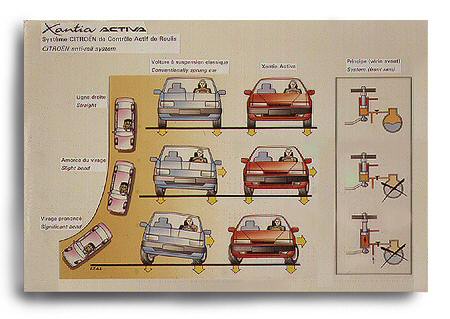Citroën’s hydractive suspension was first introduced on the XM and is a refinement of Citroën’s justly famous oleopneumatic suspension first seen on the Traction Avant as long ago as 1952.

Hydractive uses a central ECU to control the firmness of the suspension, cutting down roll and sharpening the reactions to the steering, while keeping the ride quality good.
At the heart of the system is a third sphere at each end of the car, in addition to the traditional wheel spheres. This is switched in and out of circuit by the computer as required – Citroën claimed in 0.05 of a second. The effect of switching the extra spheres out of circuit is to firm up the suspension considerably, as the springing is handled by only 2/3 of the gas volume. This gives the system two different modes: normal (soft) and sport (firm). The basic suspension set up can therefore be made quite soft and comfortable for normal driving, with the computer automatically switching to firm mode and back when conditions require, giving owners the best of both worlds: a wonderful ride and superb handling.
The microprocessor based control system has inputs from five different sensors:
- gives information on the angle and rotational speed of the steering wheel
- monitors the speed of movement of the accelerator pedal
- assesses braking effort
- measures body movement
- measures vehicle speed
These help the computer to determine the overall sensitivity of the system.

In addition to the height lever present on all hydraulically suspended Citroens, Hydractive cars posess a mode switch. This enables the driver to select the normal mode, or a firmer program – ‘Sport’. With the original Hydractive (retrospectively called Hydractive 1), selecting ‘sport’ simply removed the centre spheres from the hydraulic circuit permanently. This was fine for twisty roads and/or enthusiastic driving, but if there was a problem (and early XMs had more than their fair share of problems), the car defaulted to ‘sport’ mode which most drivers found too hard for normal driving conditions. However, Hydractive 2 – fitted to later s1 XMs, all s2 XMs, and Xantia VSX and Exclusive specifications – the parameters were changed. Setting the switch to ‘sport’ keeps the car in normal mode, but makes to the car react and switch to the firmer settings earlier and stay there for a bit longer before softening up again. This can easily be identified within the car, as the switch is labelled ‘Sport’/’Norm’ rather than the ‘Sport’/’Auto’ of Hydractive 1.

The Xantia brought a further advance, Activa. Based around Hydractive 2, but with body position sensors detecting the amount of roll, a higher volume hydraulic pump fed fluid to variable length links between each suspension arm and the anti-roll bars. This allowed the Activa to maintain a totally flat attitude, even in very hard cornering. As this ensured the tyres were always flat to the tarmac, the cornering capabilities of the car went up dramatically. However, the Activa’s ride suffered badly, and the body position sensors often disagreed, causing the Activa to perform a little ‘dance’ while stationary at traffic lights.
The launch of the Mk1 C5 saw Hydractive 3 bring a new feature – automatically variable ride height. At speed, the car automatically lowers itself to increase stability. However, Hydractive 3 on most Mk1 C5s does not offer the ‘Sport’ mode of Hydractive 1 and 2 – this is reserved for Hydractive 3+ on the upper models. The C5’s hydraulics saw the suspension separated from all other functionality, with the brakes and steering moving to conventional systems. The suspension moved to a new fluid, LDS, and “mushroom” shaped spheres, together with an electric pump which started to pressurise the system as soon as the car was unlocked rather than waiting for the engine to be started. Although widely rumoured before launch, the C6 did not feature a rumoured “Hydractive 4”, but used the Hydractive 3+ of the upper C5s.
The launch of the Mk2 C5 saw a further step away from hydraulics, with Hydractive only being fitted to top-spec cars. Again, Hydractive 3+ was used, with lower-spec cars having the same steel springing as the Peugeot 407. The C4 Picasso & Grand Picasso saw another worrying sign for the future of hydraulics, with conventional pneumatic self-levelling being available on the rear.
Hydractive 4 will, if and when it arrives, probably offer “dynamic levelling”. Each wheel will have a separate height corrector and a pair of spheres, with each wheel able to be independently switched between a firm and a soft setting. Separate height correctors will help to ensure that body roll is kept to an absolute minimum – in effect, dynamic levelling, preventing pitch, yaw and roll.


